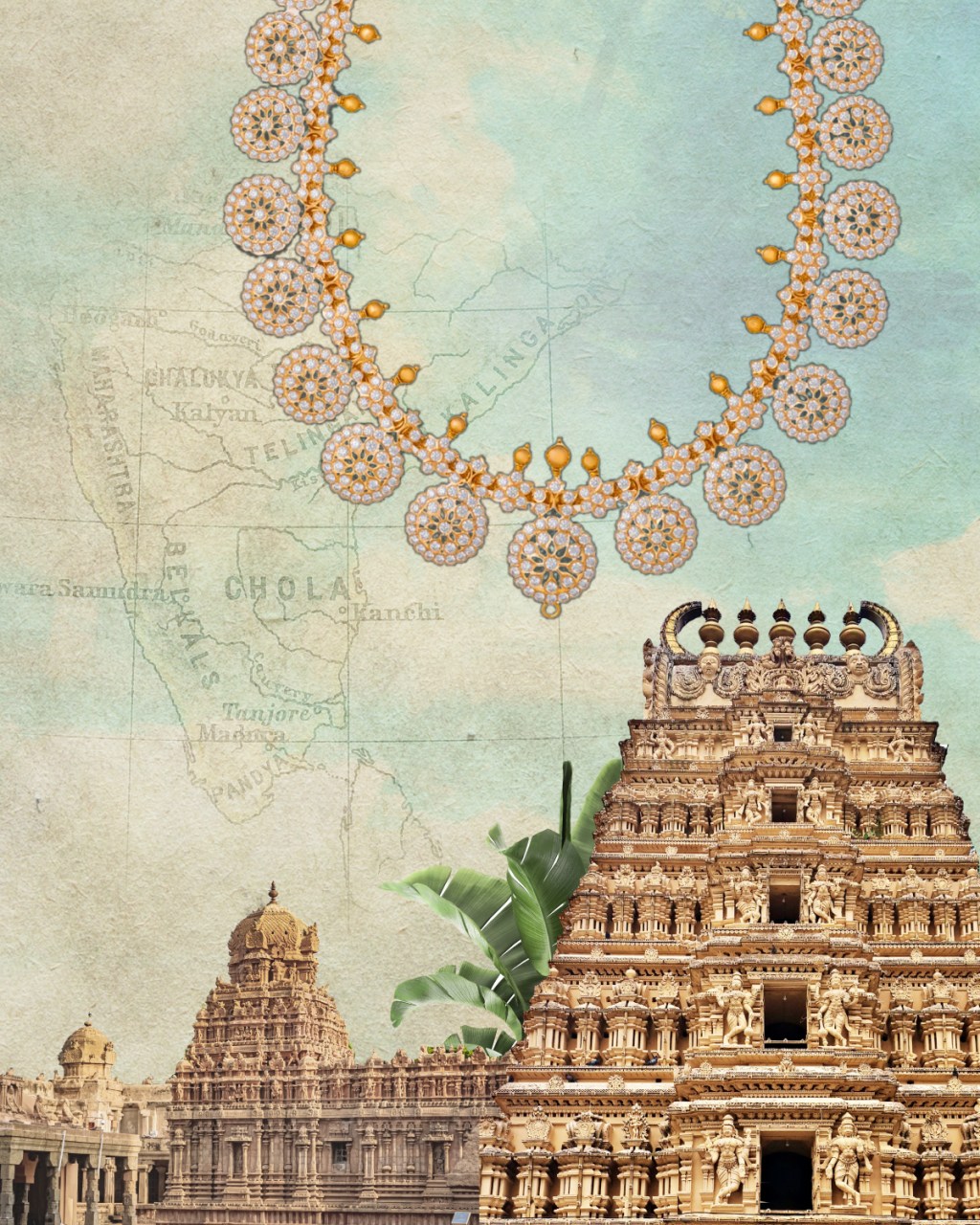Diamond Arm Candy: A Sparkling History of Arm Jewellery
Shape shifting its way through history, natural diamond jewellery on the arms have bejewelled the Gods, Goddesses and royals to present-day brides, forming a crucial piece of South Asia’s jewellery heritage.
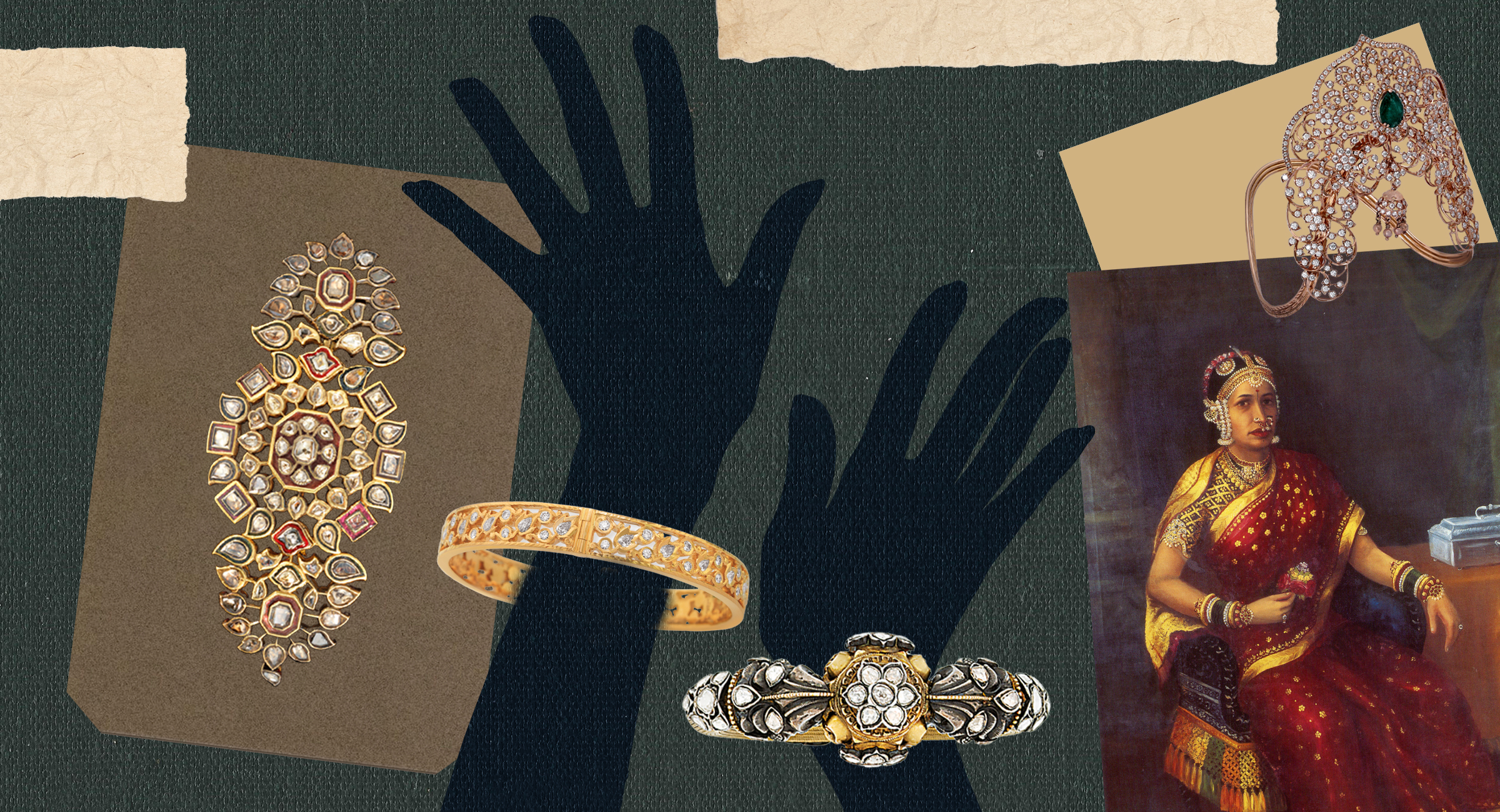
Jewellery does more than just sparkle, no matter its make. It is, of course, a signifier of personal style, wealth, social and cultural status, marriage, and much more. But in South Asia particularly, jewellery is also believed to have health and wellness benefits based on which part of the body it is worn on, irrespective of the gender of the wearer.
When it comes to jewellery worn on the arms – bangles, armbands, armlets or other, both aspects apply. Wearing arm jewellery has been a tradition for thousands of years, some estimate more than 3,000 years ago during the Gandhara Period when the arm ornaments were seen worn by Bodhisattvas, Hariti, Panchika and males and females of royal status. The Dancing Girl of Mohenjo-Daro, one of the most recognisable historic statues, is also seen wearing a series of bangles and armlets nearly covering her left arm and forearm, as well as armlets on her right arm. Barring a few such rare historic examples, the origins and history of jewellery worn on the arm, both chronologically and geographically, are blurred at best. So, we turned to jewellery historian, author, and the Chief Curator of the World Diamond Museum, Dr Usha R. Balakrishnan to help navigate the history, significance, and traditions behind these particular pieces.
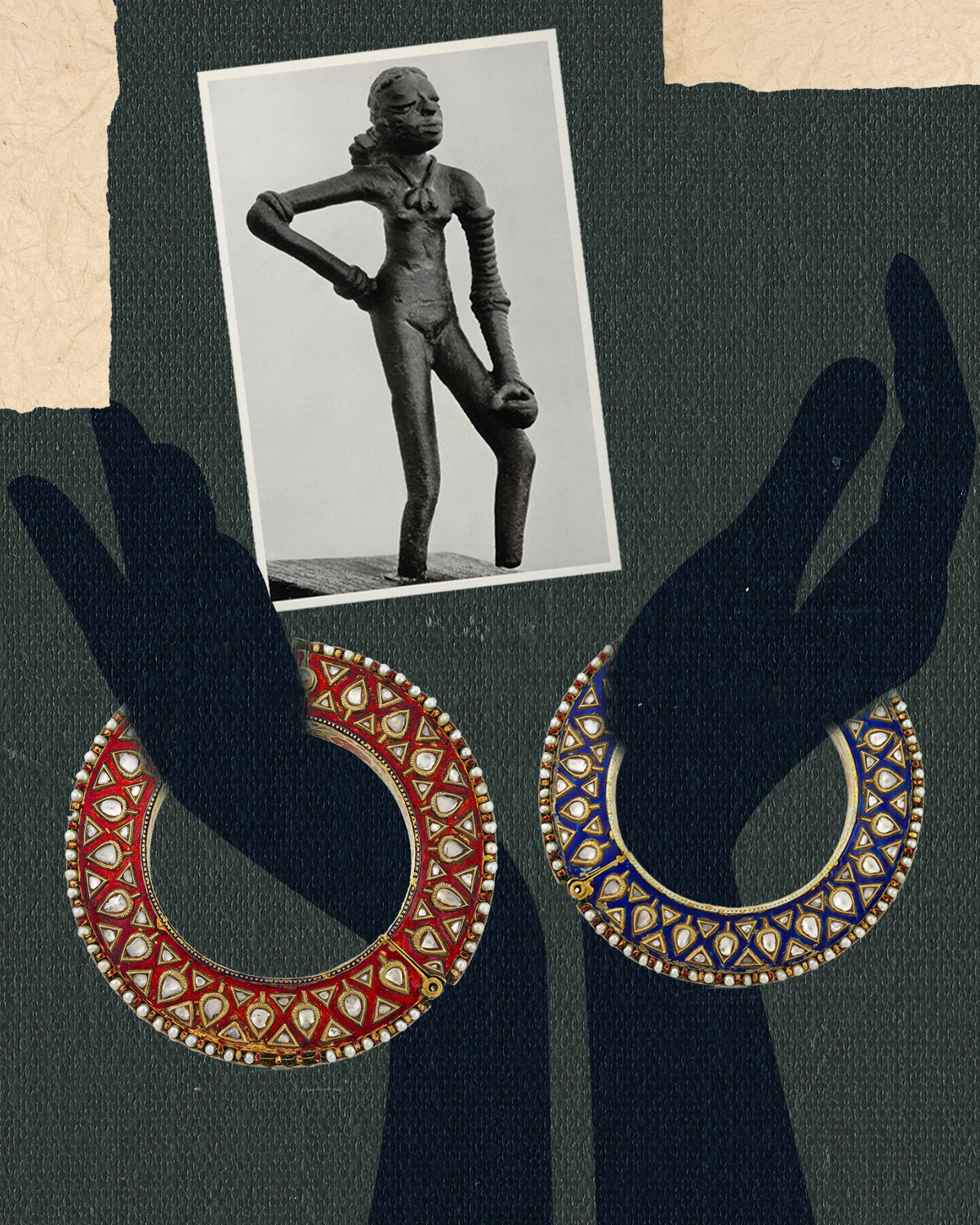
Image courtesy: Saffronart
Arm jewellery takes different forms as well as designs ranging from a simple unornamented armband worn on the upper arm to circular bejewelled armlets inlaid with precious and semi-precious stones like rubies, emeralds, and natural diamonds as well as spinel, pearls, jade, amethyst, etc. However, as far as the reason behind wearing jewellery on the arms goes, “it cuts across different stratas of society, between different communities, and religious groups,” noted Dr Balakrishnan. The reason, she added, is that arm jewellery is believed to stimulate the pranic energies that flow through the body through specific pulse points, as well as to deflect nazar, or the evil eye.
“Arm jewellery is believed to stimulate the pranic energies that flow through the body through specific pulse points, as well as to deflect nazar, or the evil eye.“
In India, arm jewellery like bangles and bajubandh form an indispensable part of a bride-to-be’s solah shringar (16 bridal adornments). In fact, tradition and customs dictate that a married woman never leave her arm bare, though the reasons behind which have faded over time, as noted by Dr. Balakrishnan. She speculated that, for instance, Kadas, circular in shape, are a symbol of the sun that gave a lot of energy to the human body and all along that arm, similar to the bajubandh which was worn on the acupressure point where the energy nadi is. When it comes to bangles, it actually stimulates that energy flow as it goes up and down the arm with movement of the wearer. The arm is a powerful energy centre and has also been believed to contribute to enhancing a woman’s fertility, giving her calmness, tranquillity and strength. Hence, the arm is never left bare, so as to stop the energy from being dissipated.”
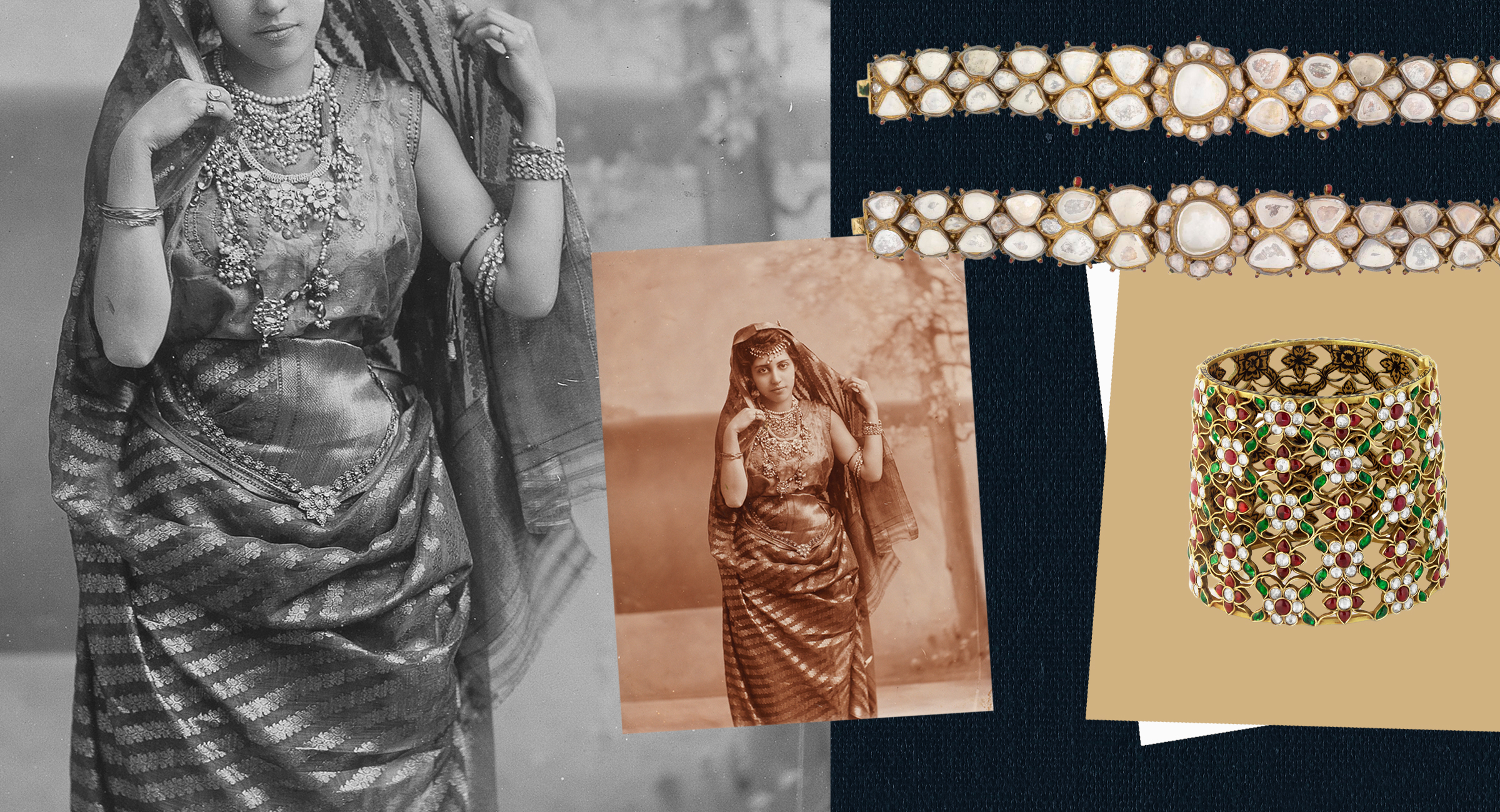
Images courtesy of: Bonhams, © The Trustees of the British Museum, Saffronart
Some of the most recognised forms of arm jewellery are the bajubandh, vanki, kada, and churi, or bangles. “During the 16th and the 17th centuries, design variations between different parts of India and different kingdoms were noticeable. For example, during the Mughal period, they wore a single large emerald, rubies, or a single spinel,” observed Dr Balakrishnan. She added that, “Natural diamonds were always used as a decorative element because even though individually, it doesn’t feature any evil eye-deflecting properties, it sparkled brilliantly and was extremely visible when worn. Remember, there were no electric lights in those days, and emeralds and rubies did not reflect the light; they did not have the prismatic effect that real diamonds had. So what immediately became visible were the diamonds. Naturally, they kind of started appearing in all the larger ornament types that became popular, and that includes arm jewellery of all kinds.” Dr Balakrishnan also highlighted that another reason natural diamonds were generously used in jewellery is that while emeralds were brought in from the New World countries and rubies from Burma, Sri Lanka and then later on Thailand, diamonds were always abundantly available in India, it being the home of diamond mining and some of the best natural diamonds.
“Balakrishnan also added that natural diamonds, which take around a billion to 3 billion years to form under the Earth, have immense energy and natural, life sustaining resources; all that is absorbed into the diamonds, unlike synthetic diamonds.“
Bajubandh
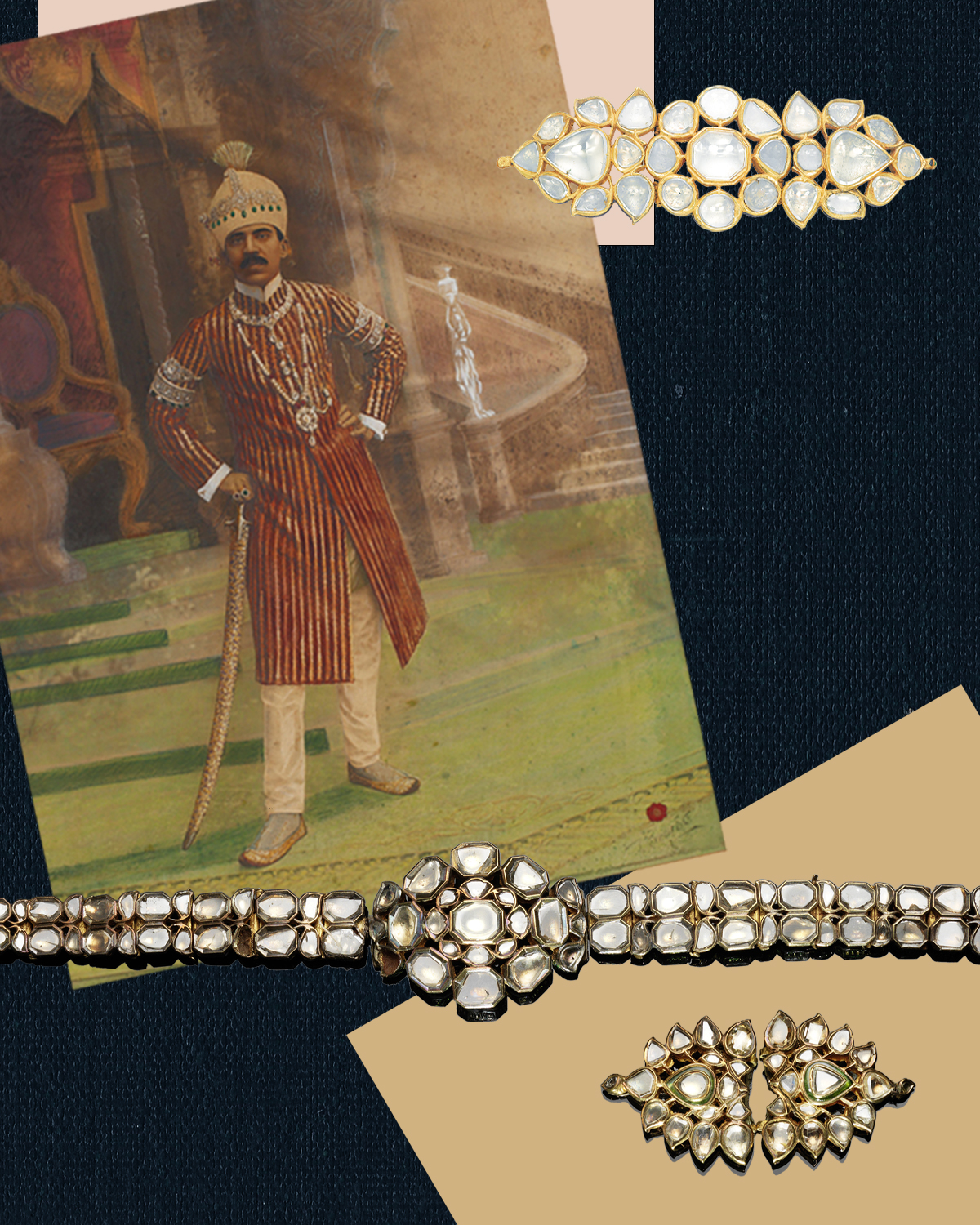
Bujbandh or bajubandh comes from two words, baju meaning arm and bandh, to close, is said to protect one from negative influences and nazar. It is also considered a symbol of health, wealth, social status, prosperity, good luck and success. Historically, it has changed and evolved in various ways in different parts of India, owing to the intermarriage between the courts and, as a result, the local jewellery designs, (and its craftspeople) that travelled. Over time and with new design integrations, the diamond cut shapes, too, changed. A bajubandh could even simply be an amulet box strung on a red cord or a yellow turmeric cord, as worn by people in the villages of Gujarat, Rajasthan and Madhya Pradesh. If it was a simple band of silver or gold, it served as a form of savings as it could be liquidated to cash if the need arose. Amongst royals, barring the addition of gemstones, there was no notable difference in a bajubandh’s design for men and women, because all the royal jewels were kept in one treasury. “The ones set with the largest, most expensive and magnificent stones, however, were the prerogative of the king,” noted Dr Balakrishnan. In its contemporary form, the bajubandh is largely worn by women during special occasions, and can be made in gold, silver, natural diamonds, pearls, Kundan, rubies, or the Navratna and can be as thin as a bangle or as wide a cuff. The bajubandh holds significance beyond its aesthetic appeal; much like the careful measurement of an individual’s blood pressure, where an elastic cuff is wrapped around the upper arm due to the major artery’s location, a bajubandh is worn on the upper arm or the bicep.
Vanki
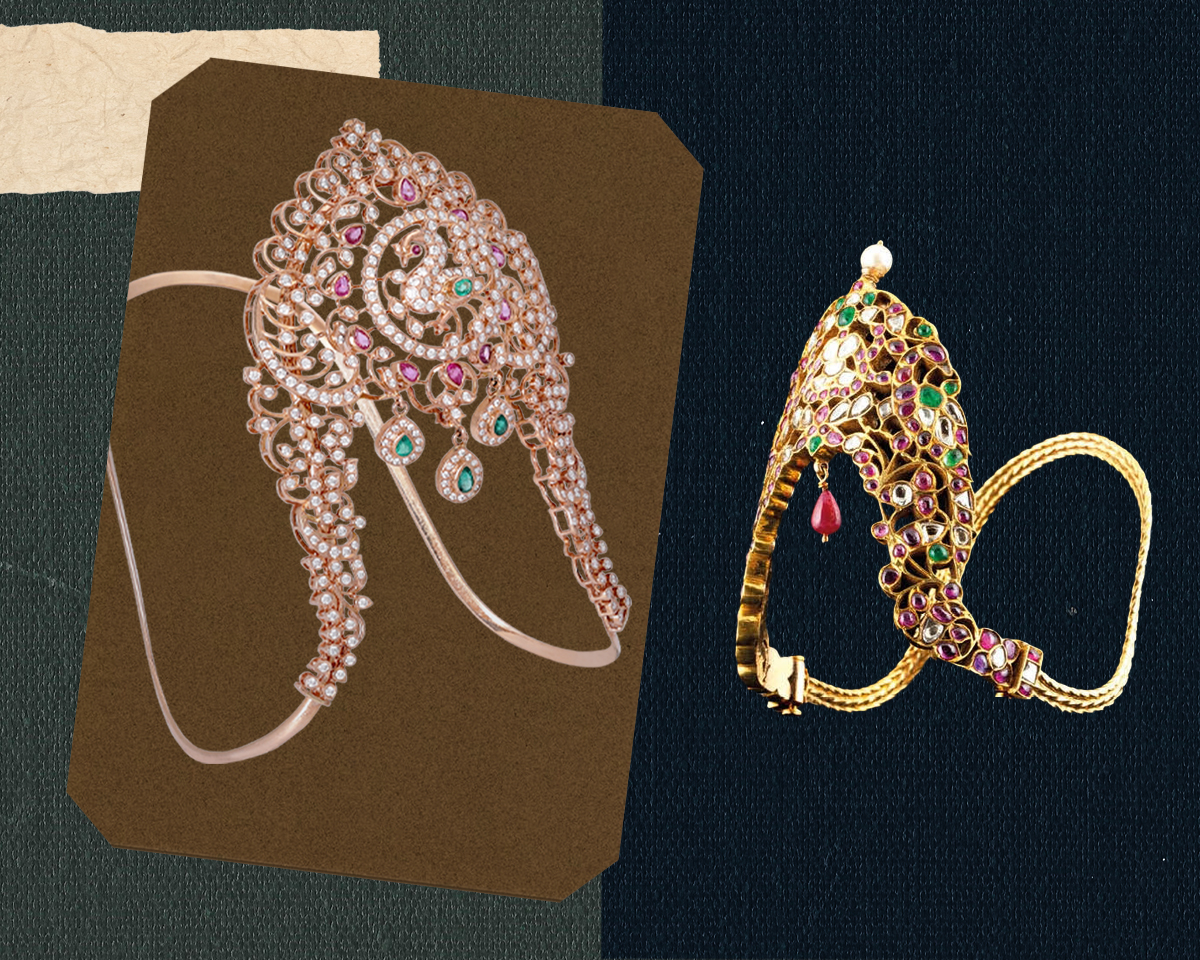
The bajubandh takes a distinctive semi V shape in the Southern part of India. Known as ‘Vanki’, it is a symbol of strength and power, and it has a telling etymology. The word ‘Vanki’ which means armlet, also means bank in Tamil, which might depict it was made as an investment of sorts, to store one’s wealth in the form of jewellery, theorised Dr Balakrishnan. However, the Vanki we see on South Indian brides today is a highly stylised evolution of something that dates way back to the Chola Period, recently seen in the movie series Ponniyin Selvan by director Mani Ratnam. In South India, the preponderance is for Cabochon rubies which were coming into the market in large quantities from Burma. Natural diamonds were also used to bring the red of the Ruby into highlight. As far as motifs are concerned, they were all inspired by nature, as a lot of Indian jewellery is, featuring parrots, peacocks and snakes as well as a riot of flowers such as jasmines because of their sweet smell, and marigolds because they’re offered in prayer.
Bangles
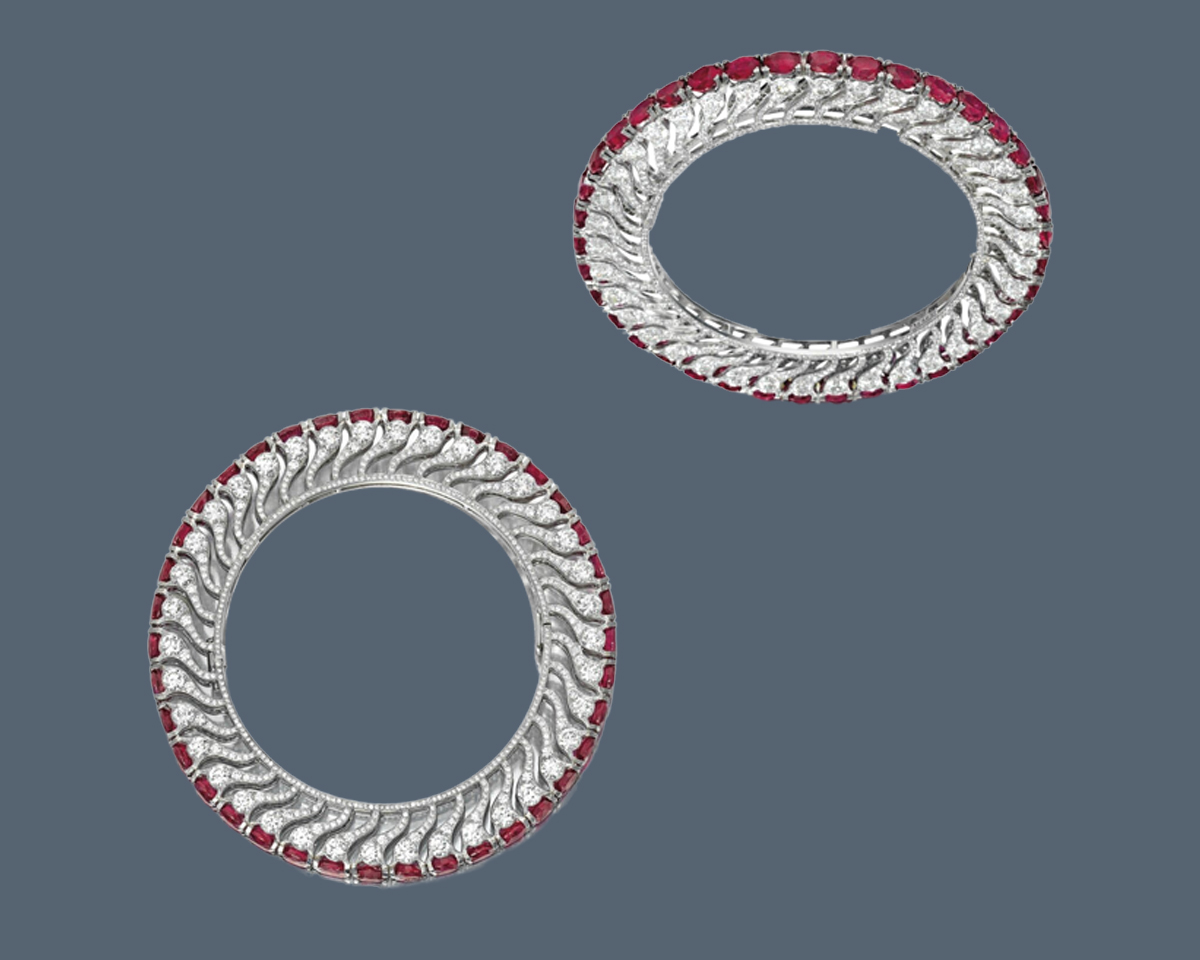
From the ivory and metal shakha-pola-loha of Bengal, the Punjabi, Gujarati and Rajputi chooda (21 ivory bangles in white and red), to the Maharashtrian green bangles and the golden Malayali Ottavala, bangles, known as ‘Valayas’ in ancient Indian literature, are typically worn in stacks almost exclusively by women. Archaeologists have excavated bangles made of various metals from different parts of India, with the highly ornate ones dating back to the Mauryan Empire and gold bangles from the historic site of Taxila. In India, the significance of the bangle for a married Indian woman is believed to be such that there are ceremonies held to adorn a woman with them. For example, Punjabi brides wear chooda for a period of at least 40 days after the wedding, gifted by her maternal uncle during a chooda ceremony held on the morning of the wedding day. In South India, the ceremony called ‘Valaikaappu’ is performed during the seventh month of pregnancy by adorning the pregnant woman in the family with bangles. Usually made from wood, glass, and metals like copper, silver, brass, gold, bangles are also often inlaid with precious stones like rubies, natural diamonds, and emeralds.
Kadas
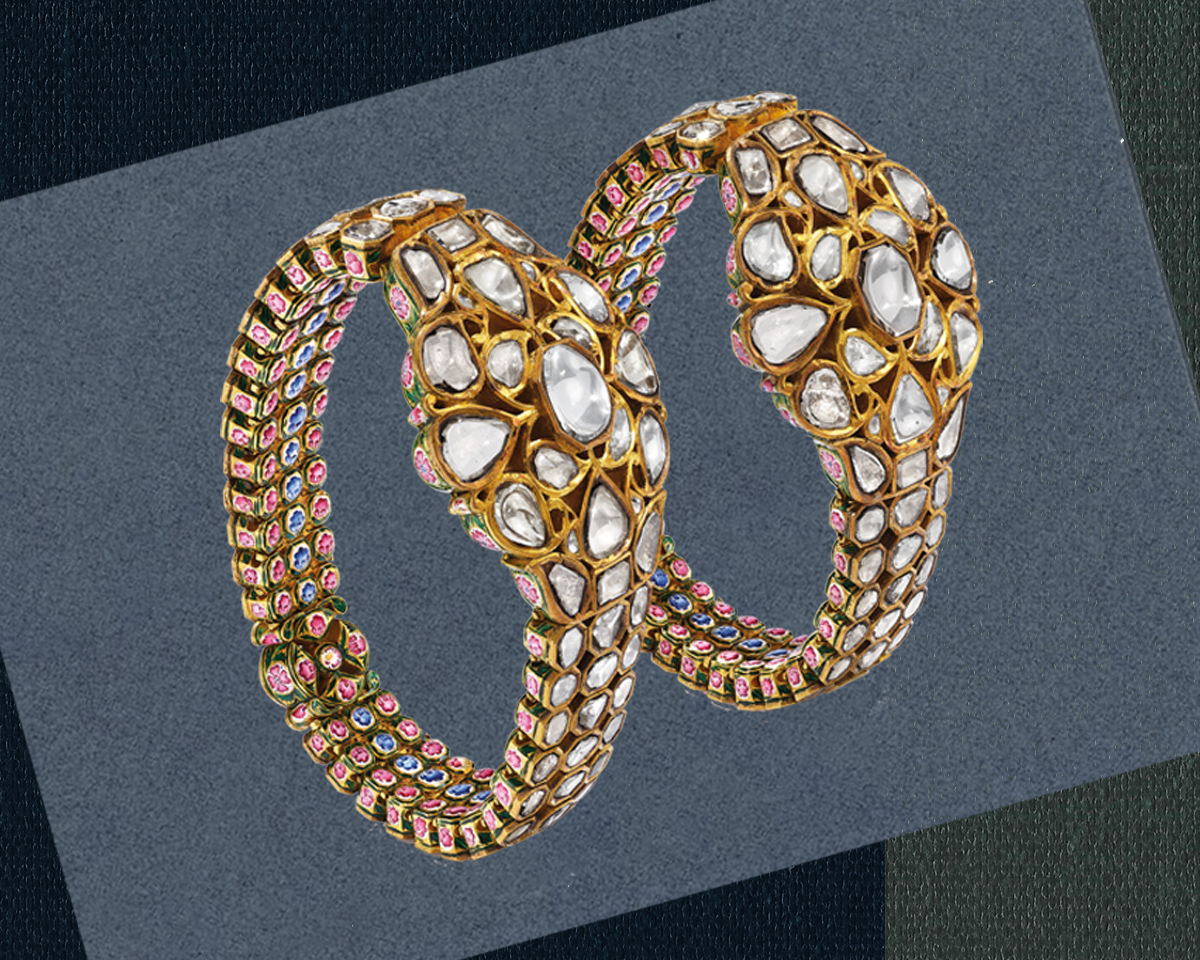
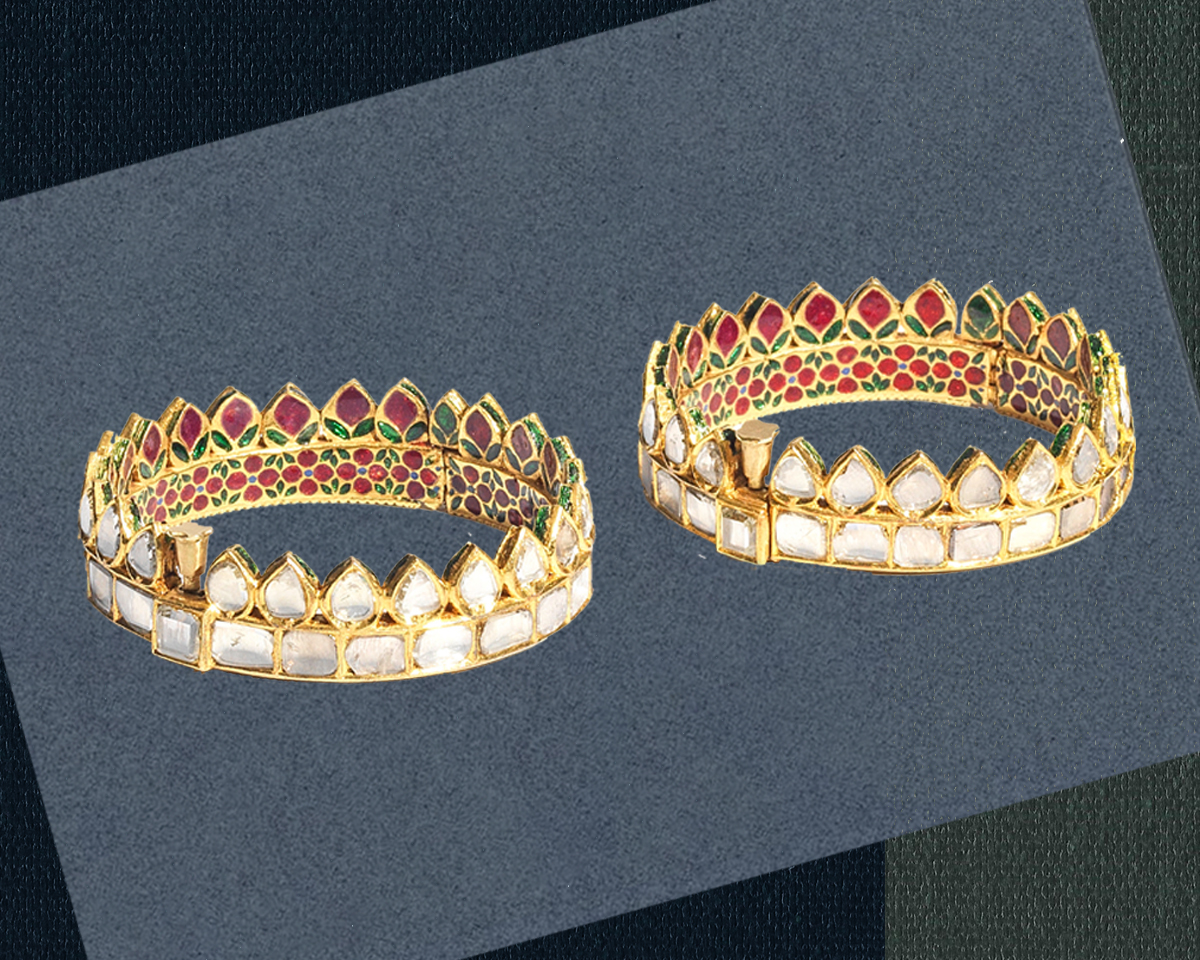
Often worn as a statement piece that hardly requires an accompaniment, the Kada started out as a humble unadorned iron ornament worn by Sikhs as a signifier of one’s faith. Images courtesy of: (Left) © 2019 Christie’s Images Limited, (Right) Bonhams
A thicker and sturdier variation of a bangle, Kadas are a statement jewellery piece worn by men and women. However, Kadas are considered to have their roots in Punjabi culture and hold great spiritual importance in Sikhism. Believed to be first given by Guru Gobind Singh Ji, the 10th Sikh Master, in 1699 as one of the 5 K’s of the Sikhs as a powerful protection, it originated as a protective ring to guard the sword arm of the Khalsa warriors during battle. A circle with no beginning and no end, the Kada represents one’s unbreakable relationship with the eternal creator and the Infinity, and is worn as a symbol of strength, devotion, and commitment to Sikh values. A simple unadorned iron ornament in its original form, today Kadas are often made from materials like steel, silver, or gold and can feature grand motifs like that of a tiger, elephant, peacocks, or Goddess Lakshmi, Kadas are studded with precious and semi-precious stones such as natural diamonds, emeralds, rubies, and other gems.
Dr Balakrishnan shared that when it comes to real diamond vanki and bajubandh, they have gone out of the sartorial vocabulary of most Indian women who only take them out for a wedding or an auspicious occasion.
“Globally, arm bands are having their modern moment in a variety of materials and styles, with a stamp of approval by the likes of Dua Lipa, Rihanna, Nicole Kidman and fashion giants like Blumarine, Prada, Fendi, Tory Burch, and Raf Simons, among others.“
As for Bangles and Kadas, while the elaborate designs with multiple stones in intricate motifs set in gold are kept locked away for a special occasion, simpler, more contemporary designs that can even be worn to work have made it to the daily wardrobe of many Indian women. In fact, a chunky, messy arm stack with multiple bracelets, cuffs, a watch and a sleek, understated natural diamond bangle with a gold or rose gold base is one of the most popular ways women are accessorising their daily outfits. For more of a traditional-meets-modern statement, real diamond kadas or cuffs set in gold often act as that show stopping piece to style with ethnic outfits.





